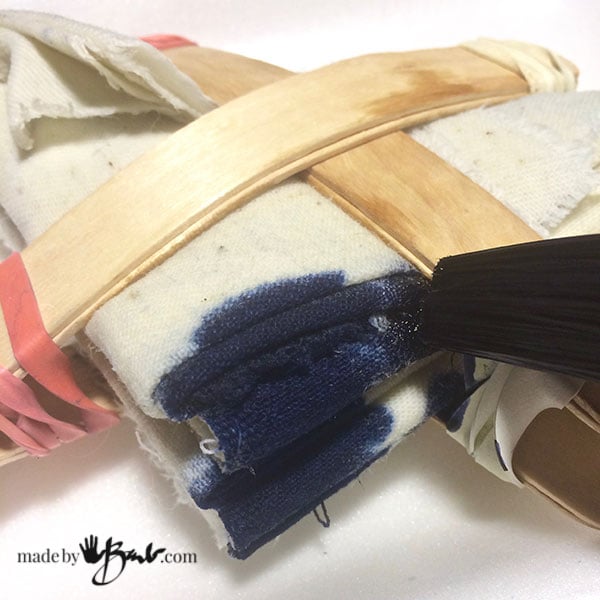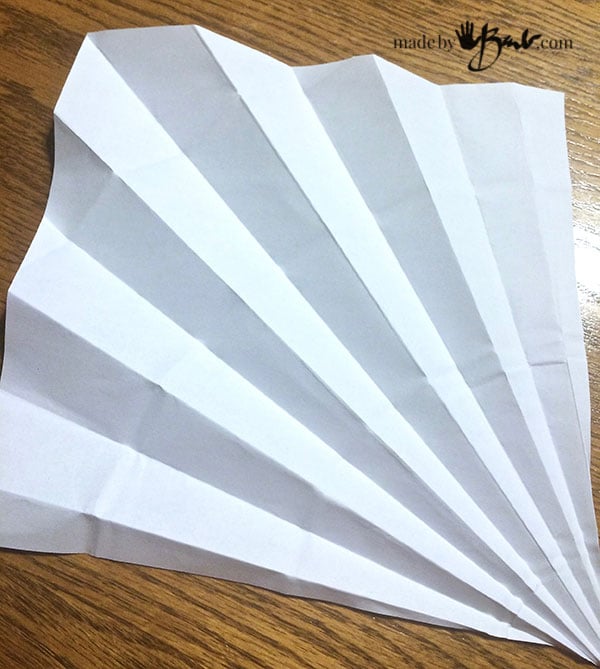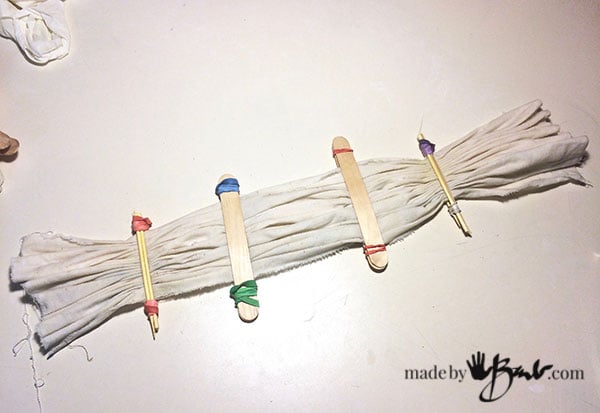Simplified Shibori Dyeing
My apologies; I have been so busy engulfed in my new art form; Shibori style dyeing. The idea came to me when I realized I had too many white blouses. If you know me, you know I LOVE to repurpose. What better way to give a new life to clothing or anything white than to Shibori dye it?! After many attempts, some not so good, I have perfected and simplified the complexity of classic ‘indigo’ dyeing. It’s quick, easy and quite manageable in a kitchen or laundry room. Don’t you just love a fresh bright blue?! I do warn you, it may become an addiction…
There will more tutorials coming up, but to start let’s keep it simple. Here is the instruction for these 4 patterns.
What you will need:
- Washing soda (aka sodium carbonate, NOT baking soda)
- Procion Fiber Reactive MX Dye in Navy blue 078
- Elastics, skewer sticks, tongue depressers/popsicle sticks
- container to mix in
- measuring spoons
- water
- waterproof gloves
- paint brush/eye dropper
- Fabric (natural fibre) of choice (I used 20″ squares of unbleached cotton canvas/duck)
I had experimented quite a bit with different dyes when starting Shibori Dyeing, but have come to love this one; Fiber Reactive Dye. It had been so disappointing to use some of the other dyes and see it wash out constantly. You can use the traditional indigo dye but that seemed like it was going to be quite an ordeal. This dye is quite easy and small scale.
Step #1 – Prepare fabric
You must however realize that you need to use natural fibers. Cotton, silk, bamboo, rayon(ramie), hemp, jute, linen etc. For my project I am using a slightly heavy weight cotton.
Cut or rip the sizes of squares you would like. These are going to pillows so I used 20″ squares. If your fabric is new, it should be washed and no fabric softener used. Soak your fabric squares in a solution of 1 cup Washing soda to one gallon of water. It should soak at least 30 minutes.
Step #2 – Folding and securing
To start thinking about the folding method there are a few things to keep in mind. To understand the folding patterns practice with some paper. Most patterns start with the accordian fold; back and forth. The idea is to have folded edges near the side of the finished shape to pick up the dye.
Once the first direction is folded, then that strip is folded in the other direction. It is a really a lesson on geometry and angles. But don’t worry, you can just follow mine. AND the great thing is that even if it has mistakes it will look great! There are triangles that can be folded after the first accordian fold. Remember a triangle has a total of 180º for the corners.
(SQUARE #1)
See these triangles have one 90º corner. The pattern created is based on squares
These triangles are different with 60º corners. The pattern created is based on hexagons
This square is also accordian-folded but it a fan way. Once that is done it is folded back and forth in the other direction.
(SQUARE #4)
Was not folded, see instructions below.
This is SQUARE #1
After the fabric has soaked, wring it out. Do wear gloves as it is quite harsh on your hands. Thin gloves allow better dexterity. Accordian folding and then back and forth triangle. Secure with the tongue depressers and elastics.
This is SQUARE #2
Accordian folded and then equilateral triangle folding. Secure with elastics.
This is SQUARE #3
This was folded accordian style but triangle shape, then accordian folded ending with the thin part on top. Secure with elastics.
SQUARE #4 was not folded, but shirred and clamped wit the skewers and depressers. Pinch the fabric into small folds, trying to keep it flat. Secure it with the skewers and elastics.
It is roughly divided into 5 sections.
Step #3 – Prepare the dye
Mix 2 teaspoons of Procion MX fiber reactive dye (Navy 078 is my favourite) with one cup of cool water. Do not breathe in the dust or please wear a mask. I try to not to mix too much so I usually mix half a cup first. This method is not immersion dyeing so it takes much less dye. Use a brush or spoon to make sure it is well mixed. You had better put the gloves on or you will have blue fingers for a while!
Step #4 – Applying the dye
This may get a bit messy so I like to use a plastic wash bin or the like (styrofoam meat trays also work well). I like to use a large brush to apply the dye to the edges. Each fabric acts a bit different for how it wicks up the dye and spreads. It is somewhat of an experiment; but that is the fun. You just never really know what you are going to get. It is a good idea to do a few small test squares until you get the ‘feel’ of how much colour you prefer or amount of bleeding the fabric does. Each fabric reacts differently to the dye. Trust me, I know…



Great job! Doesn’t that look interesting and mysterious?! To keep the dye damp the pieces are placed in plastic bags carefully to keep dyed sections from touching too much.
Step #5 – Heat set the Dye
It is now time to set the dye with heat. There are few choices. You can use a small amount of heat (20ºC+) for a long period of time (24 hours) or a higher amount over less time. Being the impatient crafter I am, I choose to work as fast as I can. I double bag the pieces and place them in a (dedicated for dyeing) microwave. I microwave for a small amounts of time till I see it start to puff up meaning that it is at the onset of boiling the moisture. I then set them under some towels to hold the heat and slowly cool.
Step #6 – Rinse and wash
Take the pieces to a sink where you can rinse them freely. Start to rinse in cool water with the bindings still on and then start to take them off. Depending on the amount of dye the fibers have absorbed there may little or more dye rinsing out. I have found that there is little release when using the cotton. Keep rinsing until it runs clear.
It is like christmas when the bindings come off and the pattern reveals itself! So much fun! Look at that great strength of colour!
After they have been well rinsed, they need to be washed. There is a suggested soap (Synthrapol) but I usually just use a bit of dish soap. The purpose is to use hot water to wash away any unused dye. I found that a bit of purple seemed to wash out and it ended beautifully blue. Wash twice, dry and you are set to use as you would any other fabric. This has much better staying power than Rit or Dylon, and I find it is easy to set with some heat.
The details of the dye are so interesting! They are like small pieces of art, each one unique. My plan? An entire bedroom remodel… stay tuned. But for now a sneak peek:
One step at a time. Wonderful blue pieces of art that are somewhat created by chance. Such a lovely easy form of art!
The guest room is taking shape… as the Shibori duvet cover is also now done!



























Thank you so much for this detailed and comprehensive walkthrough, I’ll definitely be trying this method myself sometime in the future!
Though I still have one question regarding the patterning: how exactly should I fold the paper/fabric to achieve the hexagonal pattern? Because every time I try to fold it (starting with the accordion fold), it turns into the square-based pattern. So if possible, could you provide some step-by-step instructions on how to fold it so that the resulting pattern is hexagonal?
The hexagon is similar to the rectangle but there is no 90º fold from the accordion edge. Each corner is 60º. The beginning is a bit tricky but then it repeats as you follow across the strip. see here: https://www.madebybarb.com/wp-content/uploads/2016/12/Simplified-Shibori-Dyeing-madebybarb-10.jpg. It becomes a triangle with same angles in each corner (60º). Hope that helps…
This is great! I have been experimenting with Procion MX dyes. I let my cotton fabric sit in a plastic bag or container with a lid overnight and rinse out in the morning. Two teaspoons seems like a lot of dye for a cup of water. I started using more dye, but have been using 1/2 gm per cup of water and there is much less rinsing needed the next day and the colors look good. Maybe the heat setting helps more dye “stick” to the fabric. Anyway, I liked the shibori folding and I will experiment with heat setting. (I do use heat when I dye wool with acid dyes.)
Yes, it is quite concentrated you could surely use less but it’s a method that uses little amount, rather than dipping. The great thing about blue is that even when it is lighter it’s still lovely, not the same with a red. ‘Time’ can be a substitute for heat, I tend to be a bit impatient. These dyes last well over time.
Hi Barb. Excellent instructions, so clear and the examples are beautiful. I’ve done shibori with indigo, but since I’ve got a small project in mind, mixing up a vat seems wasteful and a bit too time consuming.
My question is how to use fibre reactive dyes for stitched shibori. I don’t fancy stitching on the soda soaked fabric, even if it’s allowed to dry. Would soaking it after stitching and drawing up the threads allow the soda to penetrate sufficiently? I imagine that solution won’t penetrate as far as the very watery dye solution, but I’m not sure if that is true. Would a longer soak in the soda solution allow greater penetration?
I realise I could try sampling, but the stitching is so time consuming and hard on the hands that I’m hoping I can pick your brain instead.
Thanks again for the fabulous site. Even if I don’t do exactly what you’re demonstrating in a post, I always get information and ideas that I can apply in other ways.
I bet the soda ash solution would penetrate as much as the dye, especially if you ‘massage’ it a bit. ‘If’ it doesn’t then perhaps the dye won’t get that far either. If that part of the fabric stays unprepared it may end up staying white anyways and not need the soda ash. ‘Hope that helps! Sounds like fun!
I have not yet tried using a microwave. Why do you say to use a dedicated one? Will the work stain or damage my regular microwave? I can’t buy an extra microwave just for craft projects.
Well, it is a bit unclear if any of the steam escaping will leave a residue inside the microwave. It is a similar analogy as to why it is suggested to not use your pots/utensils for the steaming. Perhaps if you double bag the bundle there will be no steam escaping, but you will have to decide that yourself. If you do not use metal inside it should not damage the microwave. Also, often there are used ones available at second hand stores for very little money. I keep mine in my laundry room near where all the washing happens.